This is one interesting thing with memory, it flashes small anecdotes in the form of feelings and emotions. In a blink of an eye one anecdote connects with the other and thus one gets busy weaving them beyond one’s control. Its like you have set the short film videos on auto-play mode on your smart phone. Everything appears so interwoven.
As I sit to gather my thoughts on paper I can hear distant sounds of music being played on the speakers. It was Vijaya Dashami yesterday marking the end of Durga Puja festivities in this part of the country in Bengal, however, the festive spirit is still quite here. Actually speaking, this festival ushers the beginning of the festive season in a land which boasts of being a land of “twelve months and thirteen festivals”. These sounds triggered the memories to flash as I am reminded of my school days back in the city of New Delhi in the 80’s when statements like the one about festivals were considered mandatory to describe the Indian landscape in the essays meant for secondary school students. Similarly, the statements like “India is predominantly an agrarian society” , “ 80 percent of India’s population lives in the villages” or say one by Tagore, which said, “ the real face of our motherland can be seen in villages”, were a few of mandatory statements which made the examiner correcting your answer scripts happy. As students studying in the capital city of India, I wonder how many of us would have really given these statements a serious thought. However even then, one particular statement seemed more intriguing than the rest. It was one where Gandhi says that the “the future of India lies in Villages”.
Village to most of us were places where our parents spent their childhood, where our grand- parents or some of our uncles and aunts lived with their families, where one would visit only during the summer vacations. Still most of us, the city kids had at least one if not two villages (one from the father side and the other from the mother side) to lay their claim upon. There were times when instead of us visiting our native village in Bihar, my grandparents visited us in Delhi . They always had interesting reasons to return which were difficult for me to relate to. The reasons such as the cow needed to be looked after as it would deliver soon, its soon the time to harvest, it’s the wedding of one of their’s next door neighbor’s daughter the next month and my grand mother needed to be there as she was the only one left in the community who happened to be well versed with all the local customs and rituals etc. On such occasions the atmosphere at home would suddenly become quite serious. This was a regular pattern and I got used to it.
Soon we got busy with our studies and exams, our summer holidays were now spent in Delhi. Letters remained the mode of communication as there were hardly any phones then. Cousins back in our native village would write letters on the behalf of our grand- parents which would repeatedly talk of crop failure, insufficiency of rain, unavailability of jobs for the young men etc. Soon most of my cousins had to leave for cities either for education or for a job hunt. It was clear that the villages were becoming unsustainable and as a result it appeared quite logical to leave the village for settling down in the urban areas for survival. This seemed more real than the dream of a future for India which lay in the villages according to Gandhi.
Now according to the 2011 census, 68.84% of the 1.2 billion population of India live in the rural areas. The number of people living in the urban areas has increased many folds since the 1980s. Urbanisation which includes both the increase in the number of people living in the cities and also the expansion of the urban centres in such manner that they engulf the erstwhile rural areas, is a global phenomenon. Infact, the developing countries look up to it as the most desirable goal and also the only hurdle in the realization of their goal of modernization. Urbanisation equals modernization. India and her neighbor China are the two major examples witnessing this phenomenon. They alone consist of 36% of the world population majority of which unlike that in the west is rural. Both these countries are huge with respect to their land mass as well as their share of population. With the current rate of urbanization at 31% it is quite likely that India’s urban population will increase to 600 million in the coming decade as suggested by the UN Habitat World Cities Report 2016. China on the other hand targets a rate of 60% by 2020 i.e within few months from now. The urbanisation plan of China which was laid down in 2013 is huge as it envisions 70 % of the country’s nearly 1.4 billion population to be living in cities by 2025. India on the other hand still awaits an all encompassing urban policy. As we all know these two nations are governed by systems very different from each other and also going by their respective report cards illuminating various economic and social indicators, these massive targets seem more achievable in the Chinese scenario than in the Indian scenario. Nevertheless, in India’s case the increase in the rate of urbanisation from 28.53% in 2001 to 31.16% in 2011 i.e 377 million of the total population in the urban areas is nothing less than a boom.
The gravity of the numbers is well understood by the experts. China’s 30 chapters long urbanisation plan is considered one of the most debatable plans in recent years. There have been reports of protests by villagers in opposition to leaving their villages for settling down in the cities. The local government comes in their direct line of fire. This rural to urban migration has also resulted in the rise of urban unemployment, which can not be ignored in the long run. In India it is estimated that around 26% of the urban population today lives in dingy slums of various shapes and sizes. Certainly, these are not the goals, the governments of these two big nations are aiming to achieve. What is that they are missing? The issue of this population shift has reached a critical stage which requires innovative sustainable solutions.
Human systems are fragile unlike the system in the wild which is sustainable. The grass in the wild blooms and withers away in a cyclical fashion without causing much concern , however, when a cultivated crop fails one season and then another it causes concern about the sustainable practices of farming. Not only the survival of those dependent on farming and its produce becomes an immediate concern but also the success of having a healthy crop in the future becomes doubtful. Sustainability as the UN definition goes is the ability to meet the needs of the present without compromising the ability of the future generations to meet their own needs. It is related to sufficiency of food , its related to the whole ecology which along with the nature includes our thought process regarding our surroundings. No system is permanently sustainable though. We have seen how gradually the rural setups became unsustainable which forced the villagers to abandon their traditional social and economic ecosystems for securing the present existence of theirs and the future survival of their children. And therefore, it becomes all the more important for us to look at the sustainability prospects of our urbanisation frenzy. Maybe, we now really need to rethink whether urbanisation is the sole precondition for modernization or not.
I am now reminded of one presentation by Professor Xiang Rong who runs the program of Service – Learning in Yunnan University way back in 2014. I had led a group of around 14 students from Visva- Bharati University where I taught Chinese language and modern literature, for a ten days visit to Yunnan University. This visit was a part of MOU between Visva- Bharati , West Bengal and Yunnan University, Yunnan. Other than my own students from the Department of Chinese Language and Culture, we had students from the department of fine arts and also some from the department of social work in the group. On my request for visiting the department of social work our host arranged for an interaction with Professor Xiang Rong. We were conveyed that the Professor communicates in English so it will be helpful for those in the group who didn’t know Chinese. We just expected a mandatory tour to the department, least did we expect the fruitful interaction with someone who has led many successful projects related to “ Service- Learning” in Yunnan Province. “ Service – Learning” we were introduced was an attempt to upgrade the Department of Social Service. It was both theory and practice at the same time we were told. Along with the volunteer work it focuses on the development of knowledge and skills required in the field. As her presentation progressed we came to know about her work with migrant workers at “ Heart to Heart “ a community organization which she chaired then. Her presentation talked about social impact of migration from the rural Yunnan to the capital city of Kunming has on the elderly. The presentation revolved around an elderly woman who was called from one of the villages on the outskirts of Kunming to assist her daughter in law in delivering baby since her daughter in law and her son , both migrant laborers engaged in construction business in the city were not allowed leave for even a week to deliver their child. The story took a tragic turn when soon after the delivery , the young father succumbed to his head injuries at the construction site. The young mother could not bear the miseries and ran away leaving the infant with her old mother in law. Cut from her social and cultural network , without any anyone to fall upon this old lady was left to beg on the streets . five years later her five years son accidently fell into a boring well while playing at another construction site. Professor Xiao Rong and her team were fortunately working with the migrant laborers when they met this old lady looking for food by the the side of a dustbin behind one glittery restaurant. Now replace the capital city of Kunming with any other such city in India, the story remains the same. This one presentation blurred the boundary gap between our two countries in no time. Indian economic and social indicators lag far behind those of China yet such experiences in the process of development and modernization connect both these neighboring countries. They open new avenues to cooperate and innovate.
This one presentation inspired us to talk on the possibilities of cooperation between India and China. For urbanisation to become sustainable both these countries need to think of indigenous solutions. The socio- cultural landscape in these two countries suggest that to be able to sustain itself Urbanisation in India and China must go along with Rural Reconstruction. Rural Reconstruction no longer remains antithesis to Urbanisation. Both India and China can provide fertile ground for this model to become a prerequisite for modernization. It was interesting to note the interest ignited by this interaction among our young students. Students could draw connections between the village adoption program under Visva Bharati University and the Community reach program under the Department of Service- Learning of Yunnan University. Professor Xiao Rong maintained that mechanical teaching cannot produce knowledge which can have any positive impact on community, service-learning is what Higher Education in China needs. Does this not sound similar to what Tagore lived by. There is so much here for India and China to learn from each other and to contribute the development of knowledge in this field.
Talking of Rural Reconstruction , anyone who has heard about Visva- Bharati University would know how close was this project to its founder Rabindranath Tagore. Right from its start in 1921 , Sriniketan under University has been closely engaged on day to day basis with the rural communities surrounding it. Tagore’s commitment was such that he sent his son Rathindra Nath who was also one among his first five students to study agricultural science from Illinois State university in America way back in 1909. Tagore invited the likes of Leonard Knight Elmhirst the noted philanthropist and agronomist to Santiniketan where Visva Bharati University is located today to guide his Rural Reconstruction Project. Rather than chosing Kolkata to start his school Tagore chose a remote place surrounded by villages for his experiments in education. He designed an educational model which combined the local sensibilities with the global vision. His ideas on education were deeply inspired by the philosophies of the civilisational states of the Orient namely, China and Japan. He talked of art and aesthetics in daily life, how the daily cup of tea becomes a ceremony in these two nations , the Chinese garden concept , the philosophy of Dao and Buddhism seeking harmony with nature etc. The local daily practices of the village communities were given serious thought, the shining example is that of “alpona” the decorative , flowy designs on floor made with rice paste was made one of courses to be taught in the department of fine arts. Students from cities would learn about this common household practice and an essential daily ritual of rural Bengal. Something similar to how a normal daily activity of tea drinking in China and Japan takes a form of art and becomes a celebration of life. Talking of sustainability, one can still see that how such models of education and community engagements have not only survived today but have rather been flourishing for quite around ninety eight years now providing livelihood to many generations after generations. This whole idea of socially engaged art has been the basis of various sustainable economic models in this part of the country. The need is to replicate it many folds around the length and breadth of the whole country. One century ago , Tagore invoked the wisdom of the orient, talked about the urgent need to cooperate. He was quite successful in doing so. Is it not now upon our leaders of India and China to take the work further?
Talking of the art initiatives in promoting sustainable livelihood solutions and rural reconstruction, it is time now to acknowledge some very successful initiatives in the present times on both the sides of our borders. As I mentioned for Tagore , Art is the key factor in the formation of the personality of an individual who contributes to the society. Kingshuk Sarkar and Rashmi Bagchi Sarkar are two such artists who work relentlessly towards the realization of their ideal of promoting sustainability through arts. This artist couple after graduating from the Department of Fine Arts ( Kala- Bhavan) have been trained under Professor Hatanaka in Kyuoto University of Art and Design and also in Saga Art University in Japan. As true followers of Kalabhavan concept of Art and Professor Hatanaka they learnt about the similar roots of art Indian , Japanese and Chinese traditions. ( Midori Yamamoto, “ Towards Sharing Art Education in China, Japan and India, Tanaka Print, Kyuoto, Japan, pp 89-103) . They are based in santiniketan quite close to villages. They are mainstream artists working with traditional mediums such as earth colours and gum tempra. They strongly believe that work under sterile studio conditions, just for one’s own gratification can never sustain for long. Their explorations led them to a neighboring village of Shealai. They initially started with their school for children there . It took more than an year to build trust and gradually it became a small art movement of its own kind. Soon the elderly joined the children in this initiative. They were provided paper and colours. Later on they were tought how to make colours from the material available in nature around them. The villagers were encouraged to look for materials around them which can be converted into brushes and tools for their art work. They were free to paint whatever came to their mind. Kingshuk says there is so much to learn from the villagers too . In one particular instance one old lady introduced them to one wild plant whose flowers were the collectible items for the children in her childhood. She suggested that how that flower could be used as block to print designs. No wonder Rashmi calls this whole village as her open studio. Now this old woman whom they call ‘Kaki ma’ which means aunty alone has some thirty thousand paintings to her credit. Similarly, her son Bhavve and his friends now instead of spending their evenings chit chatting and drinking, invest their time and energy in making handicrafts from bamboo and wild grass .
BONDHU artists have curated many of their own exhibitions. They will shake hands with you and will offer their ‘namastey’ with folded hands without any hesitation. They will proudly describe their work in their own language . They are no longer limited by the bounds of language, caste, colour, race and even nationality.
They have their own little cooperative store managed by them from where you can buy any hand -made product made by them . Apart from this they have started one local market which is called BONDHU HAAT something similar to the well known SATURDAY HAAT started by the Shyamali Khastigar (1940- 2011) as a model of sustainable living here in Santiniketan. BONDHU HAAT is however, small in size and the products they sell are mainly artistic renditions.
Similarly, Rashmi and Kingshuk now have also started making their own paper with agricultural waste. Their training in Japan has come handy. Bhavve and his wife have rolled out huge sheets of paper from the agricultural waste. Papers made by them is in huge demand among the artists world wide. It is completely chemical free. Infact, their work was a topic of one of the papers’s presented at the SUSTAINABLE CITIZEN FESTIVAL at Copenhagen in 2014. The Department of Craft and Design ,Visva Bharati has felicitated the BONDHU family. One can see certificates of commendation nicely framed and hung on the walls of their mud houses. It is not a mean achievement. BONDHU members have conducted workshops in various universities and schools. Infact, they have revived the department of paper making in Sriniketan, Visva Bharati which was lyinfg non functional since very long time.. The main reason is that their process of paper making is sustainable whereas the process used earlier in the department could not be sustained due to high cost, cumbersome process and toxic chemicals used in the process. Students collect raw material from the premises of their own department. One can feel Tagore smiling from heaven.
Rashmi spoke more regarding the economic sustainability of hand- made paper. She told that as an artist whose mainstream work is painting she would never like to compromise on paper. So she would make her own paper earlier. However, now she buys paper from the BONDHU paper makers. The availability of work in the rural areas is otherwise cyclical in nature. Everything depends on the sowing and harvesting season . So when the BONDHU members in the village are not working in the fields , they are busy making pulp for paper. This pulp can be stored during the rainy season. Even the pulp can be sold.
Now this paper making process helps the environment too. The paddy harvested with the help of machine leaves the straw useless. This straw can no longer be used to cover the roof tops as is the important and sustainable practice in rural India. So the farmer is left with no option but to burn the stubs . The smoke caused by this burning of stub is pollutes air. Infact in the capital city of Delhi one major environmental concern is this burning of the stubs in the adjoining areas of Punjab and Haryana. Here in Shealai , the BONDHU artists collect this stub and use it for paper making.
BONDHU has encouraged many other villages to start similar initiatives. Art has not only given them the respect they were earlier denied but also a source of sustainable livelihood. Had BONDHU not come to them, these landless labourers would have had similar fate as that of the old lady and her family in Kunming.
They now have one production unit called KRIYA which is an extention of their BONDHU ART INITIATIVE in the town little away from the village.
Once in an interview to one editor of one Business magazine of China, Kingshuk said that an artist must have honesty and self pride. The editor asked what about your own mainstream work, does not it get impacted in the process? Kingshuk gave a very beautiful reply. He said, ‘ yes, both of us would have continued painting daily , however we need to detox to keep the artist in us alive . We have chosen to slow down to de-tox and refresh,” This sums up their initiative on sustainability.
In China , similar art initiatives have come to light . One case in point is the “Mentor’s School” “Xiansheng Shuyuan” located in the Liang He county in one remote corner of Yunnan bordering with Myanmar. The remoteness of this place can be judged from the fact that this whole county has only three roads leading towards it, one has to wait for weeks for any magazine to reach , in all probabilities it may never reach the subscriber. All those who could leave this place has left barring few who run small shops. With no place of entertainment , this place was a sad place to live till the chance arrival of one artist called Xin Wangjun in 2015. Xin Wangjun is no new comer in the art scene. He has been honoured Number one on the list of most noteworthy young artists in China in 2009. Xin rented a two storey courtyard house ( traditional Chinese house with neighbors sharing one common courtyard) and turned it into an inspiring place with reading hall, gallery, painting lab and guest room. He has since worked with 5000 children who have been left behind either with their grandparents or by their own at a very tender age by their parents. Their parents have been forced to leave their county for cities in search for jobs. These children have found their childhood back in through art. The works by these little raw artists have travelled 1000s of kilometers to mega cities in China. In Beijing itself their works have been showcased in almost all the important galleries.
This experimental school has been replicated in other places as well, two of them in Yunnan and three of them in Shandong.
One particular innovative art experiment called “ the sword and the shield” MAODUN has been successful in channelizing the raw spirit of the children. In this one artist uses a long brush as a sword against a sheet of paper or canvas which is held by another artist to shield the brush attack. The result of this art performance is extraordinary art work. The students of Art Centre in Chong Qing, Sichuan province have reproduced this experiment successfully.
The children are no longer called pitiable left behind children, they are budding artists who are completing their education in the local school as well and those youngsters who never saw any value in returning back now see hope. They are coming back. Liang He county is now turning into a livable place which is finds itself strong enough to sustain its future generations. Just imagine the happiness in the hearts of those parents working as migrant workers in the cities knowing that back home their children are happy and healthy.
This is another example how through art that ‘old lady in Kunming’ like many tragedies can be averted.
Another successful story is the story of Cui Gang Village in Anhui Province of China. One Artist Mr. Xieze was inspired by the remoteness and serenity of this place when he was visiting a friend there. He immediately asked his friend to look for place for him. This amused his friend though. However, Xieze was determined and the month of June in 2012 became the day when the Cui Gang had her first residential artist. Cui Gang is situated near the Dongpu water reservoir which supplies water to the provincial capital city of HeFei. There were strict regulation from the local government not to set up any industry which has a potential to pollute water. While the locals saw it as misery , Xieze saw it as an unique opportunity to fulfill his dream. He held his first art exhibition there. This caught attention of many like-minded artists. Very soon many people from big cities flocked in looking for place on rent. And thus the whole village got converted into a village of creative minds.
In this case the intervention of the local government has been very remarkable. With more people choosing this place because of its clean air and crystal clear water, the local government saw an opportunity to start organic farming there. Today with the help of the local government Cui Gang has its own water treatment plant and solar panels producing light and energy. Apart from this the government has put a ceiling on rent . The rent cannot exceed 800 RMB and the minimum period of contract has been increased to 15 years . The landlord can increase the rent by 5% every six years. The landlord however, gets compensation from the government. Such visionary policies are to facilitate free lance artists and their social projects.
Xieze believes that art does not belong to big masters only. Working on his social project are no professional artists . However, their rawness is inspiring their work . The residents run a local market , something similar to our BONDHU HAAT and also the SATURDAY HAAT of Santiniketan. They sell local produce and their artwork. There are music studios, photography studios , local kitchen etc. Visitors can chose to visit the studio of their choice , they can participate in the process of making art and then enjoy the local cuisine in peaceful and serene surroundings. The local kitchen is quite profitable enterprise.
What I admire the most is the Cui Gang’s model of grievance redressal. The rules have been agreed upon locally in advance. This is important to maintain a balance between rising aspirations of the locals and the sustainability concerns of this art village. This redressal mechanism prevents the conflict between the locals and the artists from escalating. Once again many tragedies linked with rapid urbanisation could be avoided.
All these art initiatives however, small or big certainly require us to ponder on the whole issue of sustainability. Can anyone claim that this issue does not concern him? Is it not the best time to acknowledge the fragility of human system? Does modernization directly translates to urbanisation? Is it not the time to acknowledge the capability of Art to provide solutions for problems critical enough to challenge our survival .Is the leadership of India and China prepared to partner on this issue? Its welcoming to note that the dialogue has been initiated in the form of China-India Economic and Strategic Dialogue on Sustainability. Let the artists and the common people be the partners of this dialogue. Let us acknowledge the local wisdom , share it among ourselves and improve upon them as has been evident from the initiatives mentioned above. In the Chinese case , I would like to interpret the success of these initiatives as “cultural confidence”, the new addition to the three that existed earlier namely the confidence in the socialist path, confidence in theory and the confidence in system. The commentors on policy may choose not to agree. The contempory art in both the countries seem to be rebuilding a local art language to address global issues. India is so diverse and I have faith that this diversity will result in many solutions. More collaboration between these art initiatives such as BONDHU, MENTOR’S ACADEMY , THE CUI GANG VILLAGE should become the focus of our respective governments. Let there be a flood of exchanges and ideas. Can we see any underlying message in the fact that nearly a century ago Tagore chose a remote Rural setting in Birbhum instead of Kolkata to establish his dream school , artists like Rashmi and Kingshuk have again chosen villagers as their BONDHU partners, acclaimed artists like Xin Wangjun found one remotest village to churn out brightest of ideas, Xie Ze’s idea of a sustainable community could be realized only in a rural set up? History has brought India and China to such crossroads where they need to learn from each other’s successes and failures and cooperate with each other to devise innovative model for development where Urbanisation incorporates Rural Reconstruction and the Artists and Dreamers are made the equal partners in the whole dialogue. Let these two civilisational states provide the most effective solutions for the creation of a harmonious and sustainable world.
Visiting teacher from China Mr. Cai Shaowei is teaching calligraphy on the hand made paper made by the students themselves. (author provided)


Calligraphy class in hand made paper

Kaki ma and her studio

中国农村艺术课堂

中国农村学校艺术少年宫

中国农村学生学习书法

广元市乡村学校少年宫建设
Author; Hem Kusum


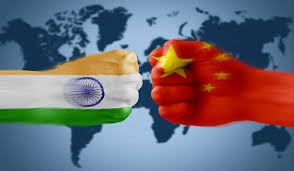

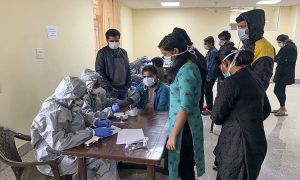







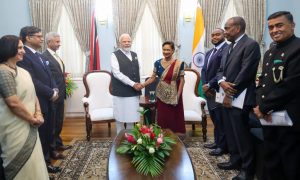

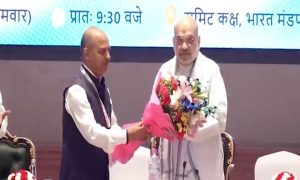

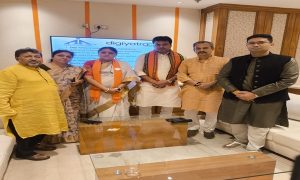



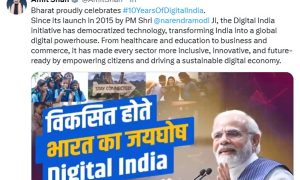

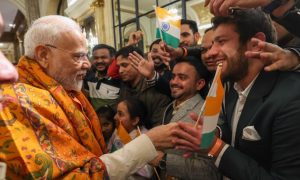

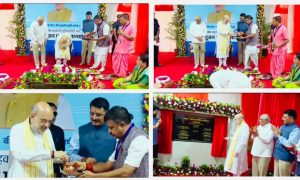



 WhatsApp us
WhatsApp us